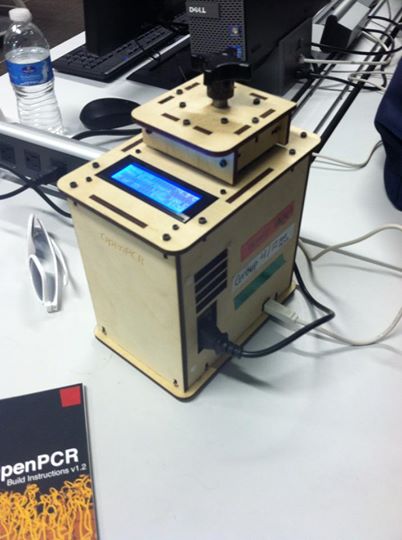BME100 s2014:W Group3 L4
| Home People Lab Write-Up 1 | Lab Write-Up 2 | Lab Write-Up 3 Lab Write-Up 4 | Lab Write-Up 5 | Lab Write-Up 6 Course Logistics For Instructors Photos Wiki Editing Help | |||||||||||||||
|
OUR TEAM
LAB 1 WRITE-UPInitial Machine TestingThe Original Design
When we unplugged (part 3) from (part 6), the machine's LCD screen went dark. This made sense because the wire went from the control board to the screen. When we unplugged the white wire that connects (part 6) to (part 2), the machine's LCD screen would display a temperature of -40.0 degrees Celsius and wouldn't change at all.
The PCR machine was run for 40 minutes for a total of 10 cycles. The LED display continued to read temperature for the duration of the test run. The temperatures were qualitatively confirmed with a team member placing their hand near the heating block for each of the time intervals on the 5th cycle, as well as by the associated computer application OpenPCR. Additionally, the mechanical components of the device were confirmed to be functioning properly including, but not limited to; the heating block lid, the heating block lid hinge, the sample holders on the heating block, the USB and power cables, and all associated wiring.
ProtocolsThermal Cycler Program
Research and DevelopmentPCR - The Underlying Technology (Add a write-up, essay-style, organized into paragraphs with descriptive headers, based on the Q&A's from Section three of your worksheet) (BONUS points: Use a program like Powerpoint, Word, Illustrator, Microsoft Paint, etc. to illustrate how primers bind to the cancer DNA template, and how Taq polymerases amplify the DNA. Screen-captures from the PCR video/ tutorial might be useful. Be sure to credit the sources if you borrow images.) There are four main components of a PCR reaction, their titles and functions are as follows: The Template DNA which serves as a genetic marker allowing us to exclusively identify a combination of nucleotides, indirectly serves as the object of measurement in a successful PCR reaction The Primers serve as initiation sites for Taq Polymerase. The molecules quickly attach to the cleaved sections of DNA at combination specific locations and indirectly initiate DNA transcription through the use of the next molecule. Taq Polymerase executes the actual act of DNA duplication, moving along the strand of DNA from its 3' end to its 5' end. As it moves along the denatured DNA strand it produces a complimentary set of nucleotides. In the context of PCR reactions this is pivotal in its inherent allowance for easy segment detection in DNA. The DNA Duplication allows for the exponential growth of a given set of necleotides. After only 30 cycles of PCR reactions, it is possible to have billions of duplicate DNA segments. Deoxyribonucleotides (dNTP’s) are the building blocks of DNA. Using the base pairs Guanine, Cytosine, Adenine, and Thymine; the Taq Polymerase forms an extremely diverse string of base pairs, each with varying legth and each of which corresponds to a different function. The PCR Process Initial Step: Heat to 95 degrees Celsius: DNA Template: Heat makes Hydrogen bonds between the Deoxyribonucleotides weaken. The Double Helix begins to unwind. Primers: Suspended in the extracellular fluid in the nucleous the primers prepare to fuse to cleaved sections of DNA. Taq Polymerase: Remains inactive. dNTP’s: the bonds between base pairs weaken and the structure of DNA starts to falter. Denature at 95 degrees Celsius for 30 seconds: DNA Template: The double helix unwinds Primers: Still remain relatively inactive. Taq Polymerase: Remains inactive. dNTP’s: Now denature and separate from their associated bases. Anneal at 57 degrees Celsius for 30 seconds: DNA Template: Seperated into two individual strands of DNA, the template now begins to cool allowing for the binding of the Primers. Primers: attach to reception sites on the DNA strand Taq Polymerase: Remains inactive. dNTP’s: with the exception of the necleotides binding the primers, the rest of the base pairs remain unaffected. Extend at 72 degrees Celsius for 30 seconds: DNA Template: the DNA strand begins being copied Primers: allow the Taq DNA polymerase to fasten to each of the single strands. Taq Polymerase: attaches to DNA Primers dNTP’s: remain unaffected. Final Step: Hold at 72 degrees Celsius for 3 minutes: DNA Template: Each individual strand begins being transcribed into two duplicate pieces of DNA. Primers: Continue to provide initiation sites for the Taq DNA polymerase. Taq Polymerase: Begins replicating DNA from 3’ to 5’ end of DNA strand dNTP’s: are left with a perfectly complimentary copy of DNA. Adenine pairs with Thymine Guanine pairs with Cytosine
| |||||||||||||||






